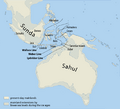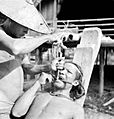Austronesian peoples facts for kids
Austronesian peoples is a term referring to people that live in Southeast Asia, Oceania and Madagascar, who are speakers of the Austronesian languages. They are thought to have originally come from the indigenous peoples of Taiwan.
Images for kids
-
Skulls representing Johann Friedrich Blumenbach's "five races" in De Generis Humani Varietate Nativa (1795). The Tahitian skull labelled "O-taheitae" represented what he called the "Malay race"
-
The New Physiognomy map (1889) printed by the Fowler & Wells Company depicting Johann Friedrich Blumenbach's five human races. The region inhabited by the "Malay race" is shown enclosed in dotted lines. Like in most 19th century sources, Islander Melanesians are excluded. Taiwan, which was annexed by the Qing Dynasty in the 17th century is also excluded.
-
Distribution of the Austronesian languages (Blust, 1999)
-
Paraw sailboats from Boracay, Philippines. Outrigger canoes and crab claw sails are hallmarks of the Austronesian maritime culture.
-
Coconuts in Rangiroa island in the Tuamotus, French Polynesia, a typical island landscape in Austronesia. Coconuts are native to tropical Asia, and were spread as canoe plants to the Pacific Islands and Madagascar by Austronesians.
-
Samoan man carrying two containers over his shoulder
-
The Javanese people of Indonesia are the largest Austronesian ethnic group.
-
Coastlines of Island Southeast Asia, New Guinea, and Australia during the last glacial period
-
Aeta fishermen in an outrigger canoe in Luzon, Philippines (c. 1899)
-
Possible language family homelands and the spread of rice into Southeast Asia (ca. 5,500–2,500 BP). The approximate coastlines during the early Holocene are shown in lighter blue.
-
Yue statue of a tattooed Baiyue man in the Zhejiang Provincial Museum (c. 3rd century BCE)
-
Proposed routes of Austroasiatic and Austronesian migrations into Indonesia (Simanjuntak, 2017)
-
Colorized photograph of a Tsou warrior from Taiwan wearing traditional clothing (pre-World War II)
-
[[Hōkūleʻa]], a modern replica of a Polynesian double-hulled voyaging canoe, is an example of a catamaran, another of the early sailing innovations of Austronesians
-
Queen [[Liliʻuokalani]], the last sovereign monarch of the Kingdom of Hawaii
-
Austronesian proto-historic and historic maritime trade network in the Indian Ocean
-
The raised bale houses of the Ifugao people with capped house posts are believed to be derived from the designs of traditional granaries
-
Tongkonan houses of the Toraja people with the distinctive saddleback roofs reminiscent of boats
-
Māori pataka storehouses
-
Cast of a Lapita red-slipped earthenware shard from the Santa Cruz Islands (c. 1000 BCE), showing dentate-stamped, circle-stamped, and cross-in-circle decorations. The latter two are shared elements from Neolithic red-slipped pottery from the Nagsabaran Site in the Philippines.
-
Māori hei matau jade pendant
-
Hand stencils in the "Tree of Life" cave painting in Gua Tewet, Kalimantan, Indonesia
-
Watu Molindo ("the entertainer stone"), one of the megaliths in Bada Valley, Central Sulawesi, Indonesia, usually found near megalithic stone vats known as kalamba.
-
Boats and human figures in a cave painting in the Niah National Park of Sarawak, Malaysia; an example of the Austronesian Painting Traditions (APT)
-
Petroglyphs in Vanuatu with the concentric circles and swirling designs characteristic of the Austronesian Engraving Style (AES)
-
Haligi pillars from the Latte period of Guam, these served as supports for raised buildings
-
A rai stone, large stone discs used as currency in Yap
-
A marae sacred site in Raiatea, French Polynesia
-
Hawaiian petroglyph depicting a poi dog (ʻīlio)
-
Carving of Rongo, the Māori deity (atua) of kūmara, from Taranaki, North Island, New Zealand
-
Teeth filing on a Mentawai man in the Mentawai Islands, Dutch East Indies, c. 1938
-
Tablet B of rongorongo, an undeciphered system of glyphs from Rapa Nui
-
An example of the abundant petroglyphs in Orongo, Rapa Nui associated with the tangata manu cult of Makemake. Rongorongo does not appear in any of these petroglyphs.
-
Wharenui meeting house of the Māori people
-
An Indonesian gamelan ensemble
-
A kanaka maoli (native) from Hawaii performing the hula
-
Kapa haka of the Māori people
-
Ramayana Ballet, traditional theatre dance from Java, Indonesia
-
A Minahasan Kabasaran war dancer from Tomohon, North Sulawesi, Indonesia
-
Hudoq, traditional dance from Kalimantan, Indonesia
-
Aloalo funerary pole of the Sakalava people of Madagascar
-
Adu zatua ancestor carvings of the Nias people of western Indonesia
-
Ki'i carving at Puʻuhonua o Hōnaunau, Hawaii
-
Toraja tau tau (wooden statue of the deceased) in South Sulawesi, Indonesia
See also
 In Spanish: Pueblos austronesios para niños
In Spanish: Pueblos austronesios para niños










































































